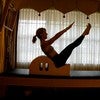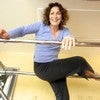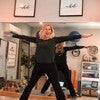Description
About This Video
Transcript
Read Full Transcript
Hi Amy again in Boulder, Colorado at the [inaudible] center of Boulder, and I have Amy helpers again. I'm back again and she's got something new for me this time or something different and I'm not sure what it is, but here she goes. It's going to be awesome though because one of the primary premises of the entire Palladia system, if you just brought it down to a nutshell, is that your body's supposed to be able to do what your body's designed to do originally the way it would be if it was still wild instead of domesticated. So primarily we have a lot of hindered joints, a lot of pain, a lot of places that are restricted. We should be able to aboriginally squat all the way down, type on our computer down there and get back up again.
And there's even been a recent study that said, if you can't get to the floor and back up again without your knees and hands, you don't have a lot longer to live. This is important. Okay, so the squat and, and one, one time I was just sitting at a hotel talking about polities with somebody in the guy next door said to me, if you could give me one movement, what would it be? And I said, well, stand up, pulled onto this chair and squat and come back up. Good. Now this is not technical squatting like you might learn in the gym. This is humans squatting, learning to do the movement your body's really designed to do and should be able to. And if it could, it would lubricate every joint constantly. It would massage and stimulate your organs constantly. It would keep your spine extremely flexible.
Your nervous system constantly stimulated in a really healthy way. It's like the whole Shebang. Plot is in a nutshell. And if you really think about how many [inaudible] exercises really are squat and stand up. Okay. All right, so no holding, no resisting, no limiting your range. You're going to go as far as you can and come back out and you're going to, we're going to start using eventually. You don't have to have anything to hold onto, but at the beginning, as you test the waters a little bit, you want to hold onto something partly because of balance and partly because if you're tight enough, and I tend to be a little bit tight myself around the ankles, as you go down, you might hit a spot that maybe makes you feel like you're going to fall.
So a little helps with that. Maybe if you can't stay on your feet totally yet, the goal will be that all your weights on your feet the whole time and you just fold and you come back up. All right, so natural, normal. Don't overthink it. Just soften your knees, your hips, your ankles go all the way down as low as you can't. No pain. Push your feet down into the floor and come back up, right, and she's going nice and far. You might not go that far. That's fine. No pain, but stay on your feet. Now Watch as she gets low, you actually want this mine to curl under. And if she can go the whole way, I might even say hurl those sit bones, tour your heels and get a nice opening in your little back. Right. Delicious. And this is the position for your role in Lanka ball. Your stomach massage is short spine, so many positions that you're going to be using it and tower, et Cetera, et cetera.
Then you stand on those feet and you push and when you start to do that, you're going to get access to tons of muscles that integrate automatically the way they're supposed to. So you don't have to tell her, use your inner thighs, pull your pelvic floor up, squeeze your abdominals. You just say stand on your feet and push. I'm going to go again. Yeah, it feels so good. It really does. Lubricated and spine. You've stretched. If we did this everyday, we would not have low back pain, deep hip flection, deep knee flection, deep ankle flection, the use of the arches of the feet. So we've got the whole Shebang here, the way the human body is supposed to work and then we spring back out and we fill again. So it's like when you make a fist and your fist gets a little white and then you release and it pinks up, you want to feel like you go into this deep compression and then pull back up and out of it again. Right?
If we did this every time we sat in a chair, instead we did this, we probably all be flying the chair that's breaking our structure down. And this is something that you're seeing tons of more information about now coming out, even though Joe [inaudible], he's wrote a book about it in the 30s that the chair, if you've read your health, is bought the chairs. What is killing our culture? Our health, our whole body, right? So if we would just release and squat and get back that range again, it would make lafell felt I the diff that you should try it. Yeah. So even as you're teaching [inaudible] exercises, try to remember that quality and don't limit range.
And don't say stop here or hold your spine too much because that's opposite of what we're trying to get, which is an incredibly natural, normal, healthy, wise in a human movement. Return to life, get back what's in there, keep it alive the whole time. Because your ability to go down there and come back up again is actually keeping you healthy and alive. Amy, how many would you recommend a person do on a daily basis? And are there any modifications? I see something on the ground that hits to me something. Yes, exactly. Okay.
So again, you know, depending on your age, depending on your health, your fitness, where you are, if you've had any kind of injuries, perhaps you've even had a knee replacement or hip replacement. Um, if you have limitations like that, obviously you have to work with them. You're going to start small, you're going to start small, and you're going to start with small numbers. So, you know, start with like three to five in one stretch, take a little break, maybe do another set later in the day. I think you're gonna find you're gonna love it, it's gonna Change you pretty quickly and you're going to start wanting to do a few more of them. And again, you know, my challenge is kind of like if you were gonna sit right now, squat and stead so that ultimately you could be doing, you know, a hundred of these a day. Oh Wow. Not as a workout as this constant functional movement. Exactly right. So start small three to five and then maybe build to 10.
I don't know that you want to do lots of reps at one time because then we're getting little bit crazy. Again, that's not natural, normal human, but just enough to start to build your strength. You're going to be surprised how it raises your heart rate because it is stimulating every organ in your body over and over. And it's using big muscles too. So that's gonna bring our challenge eventually not do holding on. Then eventually no hands. Eventually no hand.
I'm going to try one heels come up. Yes. So your heel, you're going to try to not have your heels come up cause that's gonna put a different pressure on me. So that's not an actual squat, that's different movement. It's not a bad thing. This is not what we're quite doing here. You can first modification other than going small would be to go a little wider with the feet. Can turn your knees out just a little bit. Yeah. Yeah. So now you're going to be a little freier. All right. You're going to get a nice deep stretch that way.
So getting a stretch and you're not trying, it's not like you're trying to force yourself to come smaller and smaller, but over time you'll find that you don't have to go as wide a stance. Now typically, unless there's a, a big uh, trauma here, a lot of work we're going to find is tightness in the ankle and Shin. So one modification right off the bat would be to just build some kind of a lift under those heels. Cause like she said, could my heels come up? I'm like, we don't really want them to, but they might have to. I see cause we're tight in here, right? So some magazines, a couple of towels, whatever you have. And it doesn't have to be a certain height.
Just just help you be able to still keep your heel down and keep your weight on your whole sole of your foot and push right and not totally get blocked by that tightness. And then over time, as the joints get more lubricated and supple, and the entire body's his whole body, there's not one cell in your body that is being stimulated and activated by this, so that the whole body begins to absorb the shock, better absorbed, the whole flection better, and the joints soften and get more lubricated. And it's that softening and lubricating that is the path to help. So that's what we're trying to do is keep every joint as luscious and full of life and fluids as possible and, and healthy, clean fluids. Get rid of the old, bring in the new, so squat, squat here. Got It. Squat, squat.
Comments
I found Amy's comment refreshing rather than scary. If all I have to do is keep squatting, I and my mother and my clients and my sister... are good for a long time
 Easy! I can even hold on to a wall!
Easy! I can even hold on to a wall!
You need to be a subscriber to post a comment.
Please Log In or Create an Account to start your free trial.
























